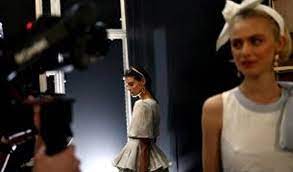LONDON (AFP): After New York, the fashion world descends on London from Friday, showcasing big names such as Burberry but also the work of young designers who could become household names of the future.
Last year’s event, billed as a comeback after disruption due to the Covid pandemic, was overshadowed by the death of Queen Elizabeth II and 10 days of national mourning.
This year, more than 80 designers are set to present their spring/summer 2024 collections, with around 50 catwalk shows and other presentations.
“It’s going to be five really exciting days full of creativity,” said Caroline Rush, chief executive of organisers the British Fashion Council (BFC).
Fashion bible Vogue rolled out the red carpet on Thursday night for a gala launch event.
But in the world of fashion, London is enduring a post-Covid slump, with inflation — the highest in the G7 at 6.8 percent in July — and Brexit combining to create a depressed economic backdrop.
That has left the British capital trailing Paris, Milan and New York in the fashion week stakes.
In a sign of its loss of influence, even British former Spice Girl Victoria Beckham has crossed the Channel to present her designs in Paris since last year.
– Fresh UK funding –
On Wednesday, the UK government announced £2 million ($2.5 million) to support young designers, which will go to the BFC’s existing NewGen programme.
The scheme, which over the last 30 years has supported the best young fashion designers, aims to launch the high-end global brands of tomorrow.
The UK government funding will go towards the staging of five fashion weeks over two years, said the BFC.
Previous recipients include the legendary Alexander McQueen, who died in 2010.
On Saturday, the Design Museum in London is presenting an exhibition celebrating young NewGen talents, and the energy they have brought to the industry.
“REBEL: 30 Years of London Fashion” showcases about 100 designs, some of which have gone down in pop culture history.
This year, about 20 designers are benefiting from the NewGen programme. Most are recent graduates, but who have already managed to dress some of the biggest stars.
Outfits by Ukrainian designer Masha Popova have been worn by singer Dua Lipa. Di Petsa has dressed actress Zendaya.
Among the more established names are 16Arlington, JW Anderson, Molly Goddard, Richard Quinn, Roksanda and Simone Rocha.
But Burberry, the London fashion house founded in 1856, remains the most eagerly awaited show.
It takes place on Monday afternoon and will be only the second collection for British creative director Daniel Lee, following on from his February show.
The ex-Bottega Veneta designer replaced Riccardo Tisci a year ago. Sales have soared in China for the brand with the distinctive check print.
On the final day, Tuesday, Ukrainian designers will present their collections, with London once again hosting Ukrainian Fashion Week due to Russia’s invasion.
The BFC is also trying to make London an increasingly inclusive venue for catwalk shows.
It has launched a survey aimed at all those working in the sector, with questions on their gender, sexual orientation, religion, and social background.
“The audit is long overdue and marks the first step towards the vital measurement of the UK fashion industry’s collective progress towards the goal of fair representation,” the BFC said.
The results will be announced later this year.
Another must-see fashion event in London is the exhibition “Gabrielle Chanel. Fashion manifesto”, which opens on Saturday at the V&A museum.
It retraces the 60-year career of “Coco” Chanel, featuring some of her greatest creations that revolutionised women’s wardrobes.
UK designer rejects ‘fast fashion’ to protect planet
Driven by a passion to protect the planet, Phoebe English hasn’t bought a centimetre of fabric or a single plastic button for her collection at London Fashion Week.
The fashion industry is one of the most polluting, accounting for up to 10 percent of greenhouse gas emissions, according to World Bank estimates.
“Fast fashion”, where clothes are bought for a few dollars and then discarded after a few wears, leads to a high volume of waste, which often ends up in illegal landfills in the Global South.
It’s an issue that preoccupies English, a 37-year-old designer who graduated from London’s prestigious Central Saint Martins arts college in 2010.
“We are producing too much too quickly, in quite an unnecessary way, and we need to really think about it,” she told AFP.
“Is that something that can actually continue with the planetary boundaries that we have?”
Like millions of people, she admits to a degree of “eco-anxiety” that at first glance is difficult to reconcile with her profession.
But it has prompted her to take radical action: a blouse made from bed linen salvaged from a luxury hotel is an item typical of her collection.
She found the fabric for a crepe blouse in a wedding dress store.
“We spend the year collecting textile waste, so that might be in the form of off-cuts from other businesses,” she explained.
Several wedding dress manufacturers send her scraps of fabric “that usually just go in the rubbish”.
The non-uniform and often small nature of the off-cuts makes the work transforming them into garments to wear “quite technical and complicated”, she added.
Given the self-imposed constraints focusing on slow and sustainable clothes, she only presents one collection per year at fashion week, which starts on Friday, while most designers present at least two.
“We can’t do it at the same speed that potentially other companies can,” she added.
– Afterlife –
“What we’re aiming for is to work in less damaging ways,” she said.
“We don’t use plastic components in our clothes. Our buttons are corozo nut or milk casein, both natural materials, and we use organic cotton sewing thread where possible.”
English thinks about the afterlife of the garment so that it is easy to sew and repair once worn and is biodegradable, should it end up being disposed of in a natural environment.
The collection is monochrome and refined: the clothes are either black or white with no prints or embroidery.
“We work with the shape and the form and the cutting and the draping, rather than necessarily the decoration,” she explained.
Many pieces are also gender neutral.
Everything is done with a small team in her east London studio, or outsourced elsewhere in England.
It is a “very niche company”, she said.
English has sold her creations in Japan, the United States and several locations in Europe and has built a loyal clientèle, who order items directly from her on the internet.
Among her clients are many artists and people curious about her approach.
While most fashion brands now say they are acting to protect the environment, many are accused of “greenwashing”.
“There’s quite a lot of misinformation,” said English, calling for “clear legislation to help mitigate some of the damaging practices”.
The British Fashion Council, which organises fashion week, has just announced a joint programme with the British textile industry to clean up the sector.
They will attempt to reduce waste and overproduction of clothing and work to support the UK’s net-zero strategy and wider climate targets.







